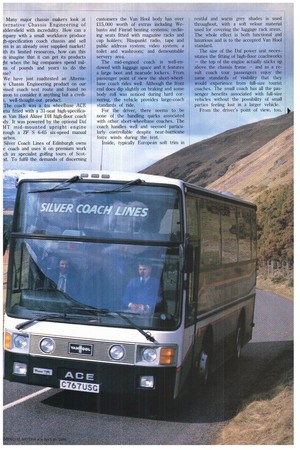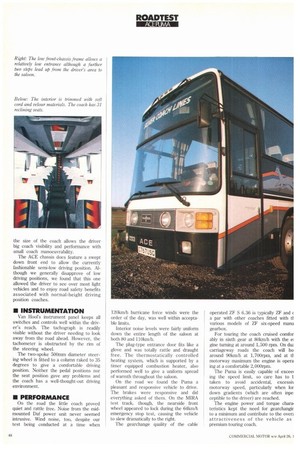SMALL COACH FEELS BIGGER
Page 46

Page 47

Page 48

Page 49

If you've noticed an error in this article please click here to report it so we can fix it.
They got it right: this Daf-powered ACE 31-seater has the qualities to appeal to both driver and passengers
Many major chassis makers look at ternative Chassis Engineering of tddersfield with incredulity. How can a mpany with a small workforce produce ;11-specification coach chassis and sell am in an already over supplied market? ith its limited resources, how can this in imagine that it can get its products r,ht when the big companies spend milns of pounds and years to do the me?
We have just roakitested an Alterna'e Chassis Engineering product on our vised coach test route and found no ason to consider it anything but a crediz, well-thought-out product.
The coach was a 4m wheelbase ACE ma fitted with a 31-seat high-specificain Van Hoot Alizee D11 high-floor coach idy. It was powered by the optional Daf HT mid-mounted upright engine rough a ZF S 6-65 six-speed manual !arbox.
Silver Coach Lines of Edinburgh owns e coach and uses it on premium work ich as specialist golfing tours of Scotad. To fulfil the demands of discerning
customers the Van Hoot body has over £15,000 worth of extras including Webasto and Finrad heating systems; reclining seats fitted with magazine racks and cup holders; Blaupunkt radio, tape and public address system; video system; a toilet and washroom; and demountable servery area.
The mid-engined coach is well-endowed with luggage space and it features a large boot and nearside lockers. From passenger point of view the short-wheelbase coach rides well. Although the front end does dip slightly on braking and some body roll was noticed during hard cornering, the vehicle provides large-coach standards of ride.
For the driver, there seems to be none of the handling quirks associated with other short-wheelbase coaches. The coach handles well and seemed particularly controllable despite near-hurricane forte winds during the test.
Inside, typically European soft trim in restful and warm grey shades is used throughout, with a soft velour material used for covering the luggage rack areas. The whole effect is both functional and luxurious and is to the accepted Van Hool standard.
The size of the Daf power unit necessitates the fitting of high-floor coachworks — the top of the engine actually sticks up above the chassis frame — and as a result coach tour passengers enjoy the same standards of visibility that they would experience from full-size tourist coaches. The small coach has all the passenger benefits associated with full-size vehicles without the possibility of small parties feeling lost in a larger vehicle.
From the driver's point of view, too, the size of the coach allows the driver big coach visibility and performance with small coach manoeuvrability.
The ACE chassis does feature a swept down front end to allow the currently fashionable semi-low driving position. Although we generally disapprove of low driving positions, we found that this one allowed the driver to see over most light vehicles and to enjoy road safety benefits associated with normal-height driving position coaches.
• INSTRUMENTATION
Van Hogs instrument panel keeps all switches and controls well within the driver's reach. The tachograph is readily visible without the driver needing to look away from the road ahead. However, the tachometer is obstructed by the rim of the steering wheel.
The two-spoke 500mm diameter steering wheel is fitted to a column raked to 35 degrees to give a comfortable driving position. Neither the pedal positions nor the seat position gave any problems and the coach has a well-thought-out driving environment.
• PERFORMANCE
On the road the little coach proved quiet and rattle free. Noise from the midmounted Daf power unit never seemed intrusive. Wind noise, too, despite our test being conducted at a time when 120km/h hurricane force winds were the order of the day, was well within acceptable limits.
Interior noise levels were fairly uniform down the entire length of the saloon at both 80 and 110km/h.
The plug-type entrance door fits like a glove and was totally rattle and draught free. The thermostatically controlled heating system, which is supported by a timer equipped combustion heater, also performed well to give a uniform spread of warmth throughout the saloon.
On the road we found the Puma a pleasant and responsive vehicle to drive. The brakes were responsive and did everything asked of them. On the MIRA test track, though, the nearside front wheel appeared to lock during the 641(m/h emergency stop test, causing the vehicle to slew dramatically to the right.
The gearchange quality of the cable operated ZF S 6.36 is typically ZF and a par with other coaches fitted with ti various models of ZF six-speed manu gearbox.
For touring the coach cruised comfor ably in sixth gear at 801un/h with the ei gine turning at around 1,500 rpm. On duz carriageway roads the coach will ho around 901un/h at 1,700rpm, and at ti motorway maximum the engine is opera ing at a comfortable 2,000rpm.
The Puma is easily capable of exceei ing the speed limit, so care has to I taken to avoid accidental, excessh motorway speed, particularly when lot down gradients (which are often inpe ceptible to the driver) are reached.
The engine power and torque chara teristics kept the need for gearchangir to a minimum and contribute to the over attractiveness of the vehicle as premium touring coach. We took the Puma over a slightly modiNd version of our Scottish route, which )w includes the A823 though Glen Eaes and Glendevon in order to increase le narrow, hilly and spectacularly scenic ;pects of the route and more accurately mutate a typical tour operation.
The short-wheelbase vehicle proved trticulary easy to handle on this road and s reduced overall length allowed all corm's to be negotiated without the need to acroach over the centre line of the road. imilarly, in town the coach proved both .ppy and manoeuvrable. The powered .eering allowed plenty of feel on winding )ads yet proved firm and positive in the ,?.ry windy conditions on the motorways. The coach has an exhaust brake which operated by a foot-controlled pad and us did not seem very effective at higher peeds. It also serves as an engine stop )ntrol. Despite being the product of Britain's smallest and newest chassis maker, the coach should provide few disadvantages or problems for the operator. The chassis is heavy duty and well specified. The air suspension is a Dunlop system and includes a raising mechanism for ferry ramps and the like. The gearbox and steering are of proven and well established ZF types and seem well suited to this particular package.
• ACCESSIBILITY
Engine accessibility is reasonable for a mid-engined vehicle and the Daf engine in this machine is covered by the benefits of Dafaid. Throughout our three-day test programme the fully laden 31-seater did not miss a beat and gave no impression of being anything other than a well thought out coach.
Overall, our fuel consumption seems a Little disappointing for a vehicle of this size, although it has to be remembered that the vehicle is as high as many a 12metre coach and is fairly heavy and not particularly aerodynamic.
It should also be noted that the worst fuel consumption figures returned were obtained on the first day of our test during the worst winds experienced in Britain for years. On the morning of the test, lorries and other high-sided vehicles were being blown over on motorways up and down the country.
While the Puma remained stable in these conditions, it is not surprising that the fuel consumption recorded while travelling north on the M6 was only 30.051/100km (9.4mpg) and 29.71/100km (9.5mpg). On the final day of the test the weather had improved and with it our fuel consumption, which was 22.91/100km (12.3mpg) for the 100km section of the M1 from the M18 to the M69. This pulled the overall consumption back to over the 28.21/100km (10mpg) mark.
The Puma also proved to he one of the fastest vehicles ever up our timed Carter Bar hill climb which was covered in three minutes and two seconds. Here, the bends on the roads rather than the power of the vehicle were the restraining factor.
The Alternative Chassis Engineering range includes Perkins and Daf-powered Puma midi chassis and full-length Perkins V8 powered Cheetah models. Critics and competitors doubt whether this small manufacturer has adequate resources to develop its product range properly, but if the proof of the pudding is in the eating, we have found nothing to support them.
• SUMMARY
The Puma proved an attractive and "together" touring coach in this Dafpowered Van Hool-bodied package.
It is well thought out; is pleasant to drive and has no niggling handling faults; cruises at a comfortable 80km/h (50mph) in sixth gear; and has plenty of luggage space and despite its short wheelbase gives passengers the good visibility associated with full-sized vehicles.
The Pumas's fuel consumption, considering that it is as high as many 12-metre vehicles, is not bad, beating the 28.2 lit/100km (10mpg) mark overall.
by Noel Millier
































































